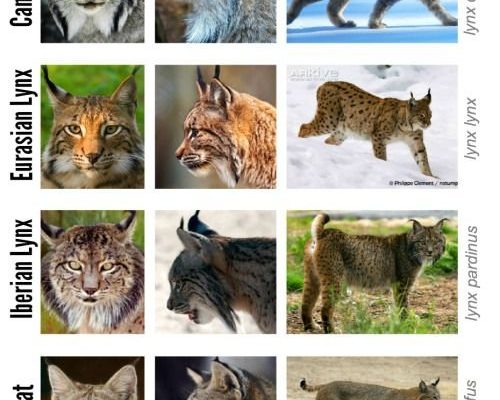![Comparing The Eurasian Lynx Vs. [Similar Species]](https://gudri.com/wp-content/uploads/2025/06/Comparing_The_Eurasian_Lynx_Vs___Similar_Species__image_0.jpg)
Eurasian lynxes are often seen as the larger, more majestic cousins of the bobcat. These two cats share some similarities, like their tufted ears and spotted coats, but they also differ in many ways, including size, habitat, and even their hunting tactics. Understanding these distinctions not only helps wildlife enthusiasts but also sheds light on their ecological roles. Ready to explore? Let’s take a closer look!
Physical Characteristics
One of the most noticeable differences between the Eurasian lynx and the bobcat is their size. The Eurasian lynx is considerably larger, standing about 24 to 36 inches tall at the shoulder and weighing up to 66 pounds. In contrast, bobcats are much smaller, averaging 18 to 24 inches in height and weighing around 20 to 35 pounds.
You might also notice their fur; the Eurasian lynx has a thicker coat that features longer tufts of hair on its ears and a short tail, while the bobcat’s coat is generally shorter and softer, with distinctive black spots. This difference in fur plays a crucial role in their adaptations to their environments. Lynxes, being more adapted to cold climates, require that extra warmth, while bobcats thrive in a variety of habitats including forests and deserts.
Additionally, both species have striking facial markings, but the lynx often sports a more pronounced beard of fur under its chin, giving it a regal appearance. This grooming might not just be for style; it could help them with camouflage in their natural habitats.
Habitat and Range
The habitats of the Eurasian lynx and the bobcat also vary widely. The Eurasian lynx is primarily found in Europe and parts of Russia and Central Asia. They prefer dense forests or mountainous areas where they can hunt for their favorite prey like roe deer or hares. Think of them as the mountain climbers of the cat world—they love rugged terrain and thick woods.
On the flip side, bobcats are more adaptable and can be found across North America, from southern Canada all the way down to northern Mexico. Their flexibility means they can live in a wide range of environments, including forests, swamps, and even suburban areas. Imagine a bobcat lounging in your backyard, taking advantage of local wildlife, while the lynx is off on a snowy mountaintop—both have carved out their own niches in the world.
Diet and Hunting Techniques
When it comes to meal time, both cats have impressive hunting skills, but they use different techniques tailored to their environments. The Eurasian lynx usually hunts larger prey, like deer, which requires stealth and patience. They often stalk their meals and use their powerful limbs for short bursts of speed to catch their food. It’s a bit like waiting for the perfect moment to pounce in a game of hide-and-seek—timing is everything!
Bobcats, on the other hand, are opportunistic feeders. They eat smaller mammals, birds, and even insects. This variety in their diet means they are always on the lookout for their next snack, often using ambush tactics. They might hide and wait for a rabbit to come too close, showcasing incredible patience and reflexes. Think of them as the clever, adaptable little brother of the lynx.
Behavior and Social Structure
Both the Eurasian lynx and bobcat tend to be solitary creatures, though their social behaviors do have some differences. Eurasian lynxes are typically more territorial, needing large areas to hunt effectively. They might establish a home range of up to 25 square miles, using scents to mark their territory and avoid confrontations.
Bobcats, in contrast, often live in smaller areas and can overlap their territories with other bobcats. They communicate through scent marking and vocalizations, including that unmistakable bobcat scream you might hear in the woods. It’s almost like they’re sharing gossip about local happenings instead of fiercely defending their space!
Interestingly, both species will occasionally interact during mating season, leading to temporary partnerships. After that, they go back to their solitary lifestyles, focusing on the next hunt or nap.
Conservation Status
Conservation efforts for both the Eurasian lynx and the bobcat vary greatly due to their different populations and habitats. The Eurasian lynx is classified as a near-threatened species in some regions due to habitat loss and hunting. Countries like Finland have made strides to protect these beautiful cats, allowing their populations to stabilize.
Bobcats, however, are more abundant and generally listed as least concern. Thanks to their adaptability and resilience, their numbers remain steady in many areas, despite facing challenges like habitat destruction and vehicle strikes. It’s heartening to see a thriving population of bobcats as an indicator of a healthy ecosystem.
Which Cat Is Right for You?
Choosing between the Eurasian lynx and the bobcat might feel like a tough decision, but it really depends on what you’re looking for in a wild cat. If you’re fascinated by majestic, larger felines with a love for snowy landscapes, the Eurasian lynx will capture your heart. You might picture them nestled in the cool woods, surveying their realm.
But if you find yourself drawn to smaller, adaptable cats that thrive in diverse environments, the bobcat could be your favorite. Their playful yet stealthy nature and ability to coexist with human developments make them particularly interesting.
Final Thoughts
In comparing the Eurasian lynx and the bobcat, we’ve explored their unique physical traits, habitats, diets, and social behaviors. While they may share some similarities, their differences are what make them both captivating in their own right.
Whether you’re a wildlife enthusiast or simply curious about these magnificent creatures, understanding these two cats adds richness to our appreciation of the natural world. Each one plays a vital role in their respective ecosystems, reminding us how important it is to protect their habitats for future generations.

